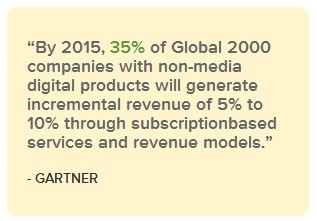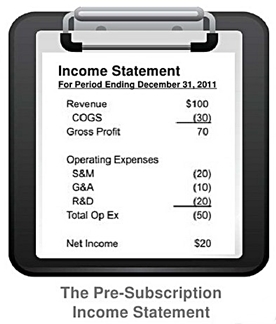As published in SocialMediaToday.
Zuora, a dominant player in cloud-based payments systems, presented at last week’s All About the Cloud Conference, hosted by the Software and Information Industry Association (SIIA). The company’s founder and CEO, Tien Tzuo, spoke about the dramatic shift in the way both consumers and companies are doing business. “Today,” Tien explained, “People would rather subscribe to products and services than buy them outright.” products. It’s happening everywhere and is having a dramatic affect on your business.
 Zuora calls this “The Subscription Economy.” Instead of single large purchases, the model is built on sustained customer relationships. For companies, the longer and stronger you can build these relationships, the more opportunities you get to first maintain, then increase recurring revenue.
Zuora calls this “The Subscription Economy.” Instead of single large purchases, the model is built on sustained customer relationships. For companies, the longer and stronger you can build these relationships, the more opportunities you get to first maintain, then increase recurring revenue.
Salesforce.com is a terrific example of this type of consumption. Product performance and customer service are both critical to establishing high customer retention, and that’s why the company religiously focuses on each. But subscriptions aren’t limited to online consumption either. Lots of new retail consumer offerings have appeared in the marketplace. New companies include:
- Lollihop sends out a monthly taste box of healthy snacks, curated for those with an active lifestyle.
- Hoseanna lets busy women order a monthly set of pantyhose, intimacy, feminine care, and other health and beauty necessities straight to their door.
- Bluum sends a monthly box containing 4-5 deluxe product samples like organic skin care, lip balm, stretch-mark cream, small toys, snacks and baby wipes to member’s homes for user testing and evaluation.
According to Zuora, however, these subscriptions introduce a new set of challenges for businesses. There’s a new set of rules for success in the Subscription Economy, and the emergence of this new consumption trend necessitates a change in the way businesses log and account for sales.
 The subscription business model is built upon future recurring costs and revenues. Whereas the “buy now” economy is SKU-based, the subscription model is plan based. Zuora contends, these ongoing subscriptions require a fundamental shift in accounting for them.
The subscription business model is built upon future recurring costs and revenues. Whereas the “buy now” economy is SKU-based, the subscription model is plan based. Zuora contends, these ongoing subscriptions require a fundamental shift in accounting for them.
Today’s general ledgers don’t accurately account for this type of sales arrangement. Tien, in his presentation, highlights three essential misses in the current accounting structure:
- They are backward looking, not forward looking
- There’s no separation of recurring versus one-time purchases
- They have no concept of subscription metrics
Today’s practices log the number of units, sales price, annual gross revenue, gross margins and close rates. Conversely, the subscription economy is based on the number of customers, customer lifetime value, recurring profit margins, growth efficiency, and reneway and churn rates. The necessary shift, Tien argues, is not in the measurement of revenue, bookings, and current profitability, but by recurring profit.
Given this, a new income statement would start with annual recurring revenue (ARR), rather than revenue alone. Churn is subtracted from the calculation, yielding a net-ARR, which represents the expected income or cash flow. Subtracted from this are the business costs associated with servicing the customer. A company’s recurring profit margin is then the remainder that can be used either to optimize margins, or reinvest to optimize growth.
Three key metrics matter to a company in this subscription economy: Retention rate, recurring profit margin, and growth efficiency. Tien stressed the importance of minimizing churn (the amount of ARR that goes away), and investing that ARR into efforts to acquire new customers and up-sell existing ones.

Tien and Zuora advise that companies target retention rates of 90%. Doing so includes strategies such as offering auto-renewals and tiered subscription plans, as well as allowing for customer service reps to handle renewals at the first level customer touch point. Strive for recurring profit margins of 50% by automating the quote-to-renewal process, and driving multi-year commitments. And lastly, shoot for a growth efficiency ratio of 1:1 by increasing customer value and making doing business a simple process.
—
Connect with Andre Bourque (SocialMktgFella) at Blog | Twitter | LinkedIn | Google+



